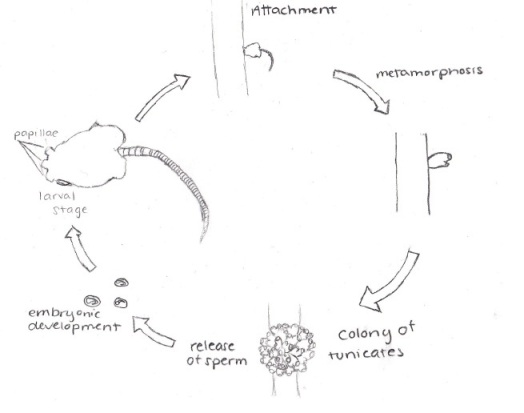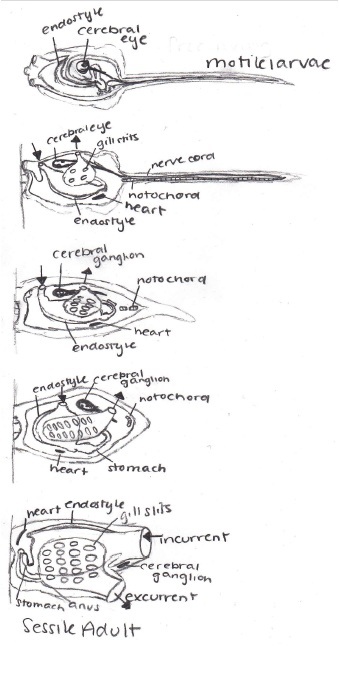Go Forth and Multiply
The Life Cycle

Life cycle drawn by me with the information from several of my references.
The life cycle begins with embryonic development. The larval stage of all tunicates is very short lived. During this time the tunicate lives off of the nutrients remaining from the yolk sack. The larva then attach to a suitable location by everting their papillae which excrete adhesives. This signals the larva to begin its metamorphosis.
The tunicates will have a final length of 2 to 2.5cm. Ecteinascidia turbinata are colonial tunicates. They grow in colonies that can be up to 14 cm in diameter.
Ecteinascidia turbinata are hermaphrodites and possess both testes and ovaries. When they are mature eggs are released via the ovary duct and sperm are released via the sperm duct. To prevent self fertilization eggs an sperm mature at different times. Sperm from other tunicates enter the tunicate through the branchial siphon to fertilize the eggs which are then released.
Tunicate Metamorphosis
 The
larval stage of all tunicates is very short lived. During this time the
tunicate lives off of the nutrients remaining from the yolk sack.
The
larval stage of all tunicates is very short lived. During this time the
tunicate lives off of the nutrients remaining from the yolk sack.
The first part of metamorphosis is the secretion of adhesives by the papillae (pictured above). These serve to attach the larva to a root. The cerebral eye begins to retract and degrade.
The tunicate then begins to reabsorb its tail along with the notochord and nerve cord. Expansion and growth of the excurrent and incurrent valve occurs
The organs of the tunicate begin their rotation and the last of the notochord is reabsorbed by the tunicate. The cerebral eye/ganglion continues to degrade. The stomach and intestines elongate.
The organs of the tunicate complete an almost 90 degree rotation. The cerebral ganglion has become very small. The incurrent siphon is superior to the excurrent siphon.
The change from a mobile larva to a sessile adult is very dramatic. There are some organs that are present in the larva and not in the adults, some of the adult organs are only rudimentary and others of present in both the larva and adults. As a larva the tunicate has a notochord, fins, papillae, an outer cuticle layer and sensory organs all of which are lost during the metamorphosis. The branchial (incurrent) and atrial (excurrent) siphons are very minimal in the larva but expand greatly to increase surface area for the adults. The development of the esophagus, stomach, and intestines continue to expand as metamorphosis continues. The organs that remain throughout are the epidermis, the inner cuticle layer, inner compartment of the tunic, the mesenchyme and its derivatives such as blood vessels. Tunicates are not the only type of animal that goes through a metamorphosis. For a look at another animal that does this check out the green frog. Another organisms that shows anti-cancerous merit is the black pepper.
Check out some of the relationships tunicates have on the interactions page.